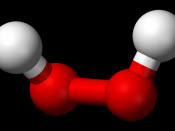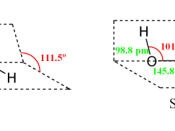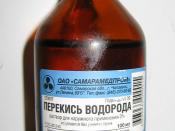Enzyme Catalysis çÂÂçÂÂçÂÂçÂÂIntroduction and Overview- In this lab, we will observe the conversion of hydrogen peroxide (H2O2) into water and oxygen gas. An enzyme known as catalase facilitates this conversion reaction. The catalase enzyme acts as catalysis, helping lower the energy needed to activate the reaction while the enzyme itself is not affected. The reaction could take place without the help of catalase, but it would happen a lot more slowly because more energy is needed for the reaction.
çÂÂçÂÂçÂÂçÂÂThe substance being acted on by the enzyme is known as the substrate, and in this case is hydrogen peroxide. The enzyme changes these substrates into products, in this case water and O2 gas. The purpose of this lab is to observe and measure the rates of conversion of hydrogen peroxide to water and oxygen by the enzyme catalase over different periods of time.
çÂÂçÂÂçÂÂçÂÂTo measure the rate of the reaction, we measure the rate of disappearance of the substrate of over time.
Potassium permanganate (KMn04) is used to indicate the presence of any remaining H2O2 in the solution after the reaction. The amount of remaining substrate is an indication of how often the conversion reaction took place.
çÂÂçÂÂçÂÂçÂÂAfter allowing an enzyme to act on a substrate solution for different periods of time and measuring the amount of remaining substrate, a rate of reaction can be calculated. And that is what the experiment boils down to, figuring out the rate of an enzyme catalyzed reaction. I predict that the rate for reaction will remain fairly constant over time.
çÂÂçÂÂçÂÂçÂÂMaterials- è·¯ Burette çÂÂçÂÂçÂÂçÂÂè·¯ 2% KmnO4 çÂÂçÂÂçÂÂç çÂÂçÂÂçÂÂçÂÂè·¯ 1M H2SO4 (Sulfuric acid) çÂÂçÂÂçÂÂçÂÂè·¯ H2O (Water) çÂÂçÂÂçÂÂçÂÂè·¯ Potato çÂÂçÂÂçÂÂçÂÂè·¯ 1.5% H2O2 (Hydrogen Peroxide) çÂÂçÂÂçÂÂçÂÂè·¯ Catalase çÂÂçÂÂçÂÂçÂÂè·¯ 1 ml syringe çÂÂçÂÂçÂÂç çÂÂçÂÂçÂÂçÂÂè·¯ 10 ml syringe çÂÂçÂÂçÂÂçÂÂè·¯ Stopwatch çÂÂçÂÂçÂÂçÂÂè·¯ Six 50 ml beakers çÂÂçÂÂçÂÂçÂÂè·¯...


